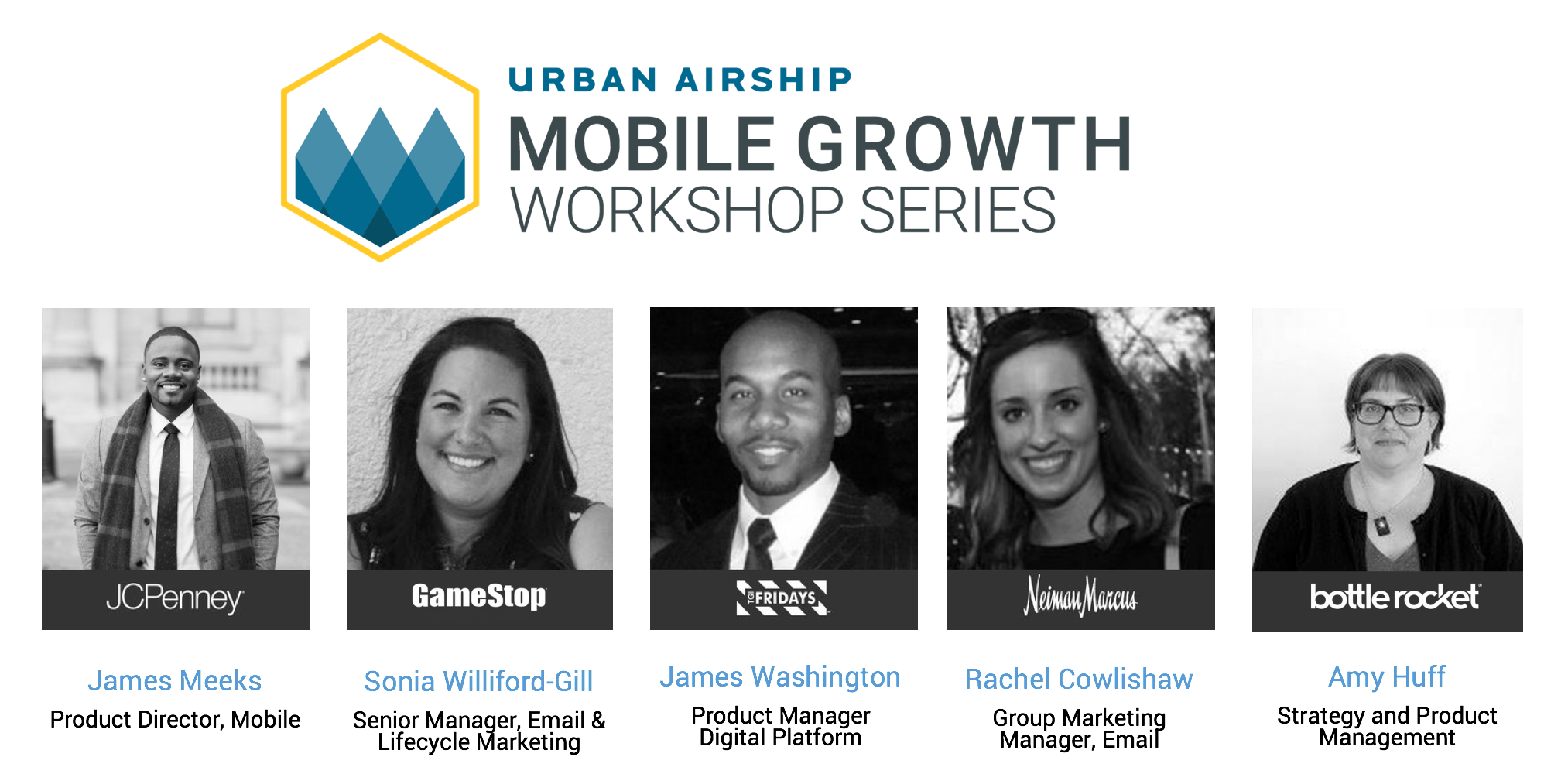
Insights from GameStop, JCPenney, TGI Fridays, Neiman Marcus & Bottle Rocket: Recapping Our Dallas Mobile Growth Workshop
Mobile pros from GameStop, JCPenney, TGI Fridays, Neiman Marcus & Bottle Rocket were the featured guests at our latest Mobile Growth Workshop, hosted by Bottle Rocket at their HQ in Dallas. We’ve pulled together a recap of the highlights here for those of you who couldn’t make it.
We hope to see you at the next Workshop! Check out our event page for more details, and register today for the next event, coming to a city near you!

Keeping The User at the Center of Your App Strategy
“We took a hard look at the app and realized we wanted to do better. And we didn't just want to put our own ideas into it, we wanted to make sure it met the needs of our customers. So, we decided to release a beta version of our new app to give customers the ability to test the app and provide feedback on the experience.” – James Meeks, JCPenney
“When we designed some features of a major airline’s app, we actually took a bunch of our employees and had them try to use it while walking around with their carry bag and pulling a suitcase. Because when you’re actually using the app, you’re going to be an in airport, there are going to be a ton of people around, and maybe you’ve got a few pieces of luggage and a five-year-old with you. You don’t want to put an app feature in a weird place where people have to use two hands. So it's trying to make our tests as real and contextual as possible.” – Amy Huff, Bottle Rocket
“The primary strategy that’s helping drive people back into our app is personalization. For example, for the people who converted, we looked at what they purchased, and when, and then send them a ‘re-order’ message based on their past behavior. For people who’ve been in the app but haven’t ordered, we’ll send a trial offer.” – James Washington, TGI Fridays
Deciding Which Data to Pay Attention To
“I think at the end of the day it all comes down to data. We went from an organization where a lot of the decisions in the past were based on opinions. We've now shifted our mindset to be data-driven. That’s our focus, and that’s how we make decisions.” – James Meeks, JCPenney
“Of the traffic that's coming, where are they going? Where are they dropping off? Where are you losing people? You don't have to dive deep in everything, just in those places that are most critical to your funnel — and then you can prioritize and work from there.” – Amy Huff, Bottle Rocket
Keeping App Users Engaged
“We try to keep our guest hats on and be as practical as possible. Because we’re not only competing with other restaurants in our space for time on your digital device, we’re competing with all the apps on your phone. So, what are we doing to earn that space and that bandwidth the user’s device? We look at it from the perspective of our users needing to have a super efficient experience. It's not Facebook. They want to get in, get what they want, and get out as fast as possible.” – James Washington, TGI Fridays
“Around 65% of our customers are mobile. So mobile is where we want to be having conversations. One way we’re doing that is with our in app inbox. Every push message we send has a little inbox message attached to it — it essentially delivers the punchline to a push message. If we send you a push notification that a game is available for pre-order, the app inbox message might have the trailer for that game and the date you’ll be able to pick it up.” – Sonia Williford-Gill, GameStop
Engage Employees to Spark Exponential App Growth
“We knew that we’d never achieve the growth we wanted to have with the app if we didn't get our associates excited about it. We’ve got more than 800 stores and nearly 100,000 associates across the U.S. So if they're excited about it, they’re going to tell customers about it. We added a price scanning feature into the app — that was something that both customers and associates found really, really valuable, and that’s helped us drive new customers to the app.” – James Meeks, JCPenney
“When we look at functionality for the app, we think about it from both the server perspective and the guest perspective. If a server doesn't like a feature in the app, they're going to tell customers, ‘Put that thing away.’ For example, we had payment service in the app that made it harder for the servers to close a check, and it wasn’t a great customer experience either. With our new service, we’ve made it way more convenient for servers and for customers, and we’ve had a massive increase in usage because now it’s a win/win.” – James Washington, TGI Fridays
Being On the Right Channel at the Right Time
“We want to leverage our rich bar heritage to ultimately increase visits in our restaurants. One of the popular things that happen in our locations are local events. In the past, we might have sent a message on Monday telling you about an in-store event happening on Friday. That’s not all that helpful. But now, we’re using localization within the app to keep people informed about what’s happening at my favorite Friday’s, and using the app to send a push notification that says, ‘$10 Burger, Wings & Beer Happy Hour tonight at 6!’ That makes it more timely, urgent and relevant.” – James Washington, TGI Fridays
“Make sure every message is part of your bigger strategy — and that you’re working with other teams who are sending messages through other channels. To avoid being repetitive with customers, it helps to draw some boundaries for the different types of customer messaging can and should do, and try to stick to those.” – Rachel Cowlishaw, Neiman Marcus
“We've worked hard to create complimentary messages across channels, and not say the same thing on three different channels. We used to have a tendency to send basically the same message in email and in push. Now we create different messages, varying them by timing or message or both. So the first message we send for promoting something like an in-store event is email because it has the longest lifecycle — it might take them a while to get to their email inbox. Then we’d send a push message about the same event, but include something more specific, like the name of the brand sponsoring the event. And then we’d send another push a few hours before the event to remind people to come. We want our messages to build across channels, not just echo. Mobile wallet is another place where we try to tie into messages we're delivering in email, and that cross-channel coordination is critical. And we want to match the message to the channel — and that means we’re not trying squeeze an email into a push notification.” – Sonia Williford-Gill, GameStop
Authenticity is Critical
“I think having a successful app has a lot to do with being authentic. When you deeply understand your brand, and you deeply understand your customers, you’ll make sure your app is an extension of that. The app speaks the language of the brand, it knows what the customer wants and personalizes it for them. When you do all that, it’s hard for the brand not to get through.” – Amy Huff, Bottle Rocket
Can’t make it to any of our mobile growth events? Subscribe to our blog so you’ll be sure to see our recaps. You can also follow us on Twitter and look for the hashtag #UAGrowth for live insights during each of our Workshops.
Subscribe for updates
If the form doesn't render correctly, kindly disable the ad blocker on your browser and refresh the page.
Related Posts


Rich Push, Thinking Outside the App & Driving Customer Loyalty with Mobile: Insights From Our Chicago Mobile Growth Workshop

